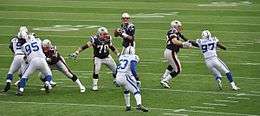Passing pocket

The passing pocket is a term used in American football to describe the area in the backfield created on a passing play where the offensive line forms a wall of protection around the quarterback.[1] This allows him adequate time to find an open receiver and to pass the ball. The offensive line will drop back slightly, creating a U-shaped protected area for the quarterback to find an open receiver and get rid of the ball.[2]
If he is unable to find an open receiver he will attempt to run the ball himself, throw the ball out of bounds to prevent a sack and/or turnover, or if there is no lane, he may collapse to the ground to protect the ball and try to avoid a fumble. Even with a well structured offensive line, the quarterback only has seconds to pass the ball within the tackle box. Moving the pocket can help avoid a sack.[3] When that fails, quarterbacks may scramble, either to gain more time for the wide receivers, to avoid a sack, or to rush the ball.
The term is used as follows: "The quarterback steps up into the pocket."
Tackle box structure
The tackle box itself can be formed using different types of protections to keep the quarterback safe.[4] The five man protection is used most often and it only involves the five offensive linemen. The offensive tackles set the depth of the tackle box by kick sliding back to around six yards. The guards are next and they will drop back to around three to four yards and watch for any extra rushers. The center will identify the middle linebacker and make sure he does not rush. If the middle linebacker does not blitz then the center will help one of the guards with his man. The different depths of the drops from the linemen helps to create space for the quarterback to step up in the tackle box and get momentum moving towards the receiver he is throwing to. This changes a little bit when six man protection is used because the tight end is now staying in to help protect the quarterback. The tight end will fan out to the tackle's depth and help the defensive end. Sometimes the tackle box is formed by a two tight end set where there is a tight end on both ends of the line.
Tackle box protection packages
The tackle box can be protected by the five linemen, two tight ends, and also the two running backs. There are many different packages that can be used to protect the quarterback. When two running backs are used, they do not set the depth of the tackle box but they do step up and clear out any stray rushers that may get by the guards and center. They are used to create more space for the quarterback to step into in order to make a good throw. There can be one or two running backs used along with one or two tight ends depending on the packages called for. Sometimes, running backs and tight ends will chip a rusher, which is to quickly block them, and then they will go run their receiving route. Tight ends can do the same thing, which means that the tackles would then have to set the depth of the tackle box.
Defensive maneuvers
The defense is trying to break down the tackle box as quickly as possible. They will try to send extra rushers to outnumber the blockers. Another tactic would be to send speed rushers off the edge to run around the tackles before they can set the depth of the tackle box. The defensive ends are sometimes able to run past the tackles and get to the quarterback before he can step up into the tackle box to protect himself better. Another maneuver that is used is the middle blitz where the defense sends multiple rushers up the middle of the line in order to get past the center and guards to collapse the tackle box and sack the quarterback. The offensive line cannot block up the middle when too many rushers are running at them. This rushes the quarterback and forces him to get rid of the ball before he is ready to do so. There are many different types of blitzes but their only purpose is to confuse the blockers and ruin the tackle box that is being formed.
When the tackle box collapses
When the defense succeeds in their goal of confusing the offensive linemen, major problems form for the quarterback. The term that is used when the defense is getting close to the quarterback is that the tackle box is collapsing. When the tackle box collapses, the quarterback is trained to do one of a few different things: to scramble out of the tackle box and look to gain yards by running, to get outside of the tackle box and throw the ball out of bounds, or—in extreme situations—to just take the sack and not lose possession of the football. This is a very tough time for the quarterback because the game is played very quickly and he may struggle to make the correct decision when his linemen do not block well on one play. A quarterback who is able to effectively react to the pocket collapsing and salvage the play is said to have good pocket awareness or pocket presence.[5]
References
- ↑ "Pocket Definition - Sporting Charts".
- ↑ "Pocket in football".
- ↑ Mallory, Bill; Nehlen, Don; Association, American Football Coaches (1 January 2006). "Football Offenses and Plays". Human Kinetics – via Google Books.
- ↑ "Football Rules for the Tackle Box Dimensions".
- ↑ Nichols, Sam. "50 + Drills to Improve QB Pocket Presence".